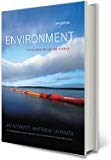
To explain: The reason behind the fossil fuels being the most prevalent source of energy and the reason behind considering the fossil fuels as nonrenewable.
Answer to Problem 1TYC
As the fossil fuels are the highly combustible compounds which are formed from the organic matter which buried thousands of years ago, they store a large amount of energy. Even small quantity of fossil fuels produces a large amount of energy. Fossil fuels, especially oil products, are prevalent today because they are efficient to burn, ship, and store. Natural gas is cleaner burning, and coal is most plentiful. They are all considered nonrenewable because they are being extracted and consumed much faster than they are being formed naturally.
Explanation of Solution
The fossil fuels are the highly combustible compounds, which are formed by the burying of the dead organisms. The synthesis of fossil fuel takes thousands to millions of years. The reason behind the fossils being most prevalent source of energy is that they store a high amount of energy in them, which makes them efficient in burning, storing and shipping.
There are three different forms of fossil fuels which are utilized by humans, namely coal, oil and natural gas. These are produced from natural process and their production takes a very long time and once they will get depleted then, they will not be replaced within stipulated time period. To produce one gallon of natural oil, the biosphere takes thousands of years. Hence, fossil fuel is considered as nonrenewable.
Want to see more full solutions like this?
Chapter 19 Solutions
Environment The Science Behind the Stories
- 1. List the five REASONS for seasons. Please be careful. I am not looking for INFLUENCES on seasons such as, Global Warming and winds. Think about axial parallelism, for example. (20 points). 2. Are we closest to the sun during the Northern Hemisphere summer or winter (5 points)? Is it called the aphelion or the perihelion (5 points)? 3. When does everyone receive 12 hours of day and 12 hours of night (5 points)? 4. During what Northern Hemisphere season do the penguins in Antarctica (the Southern Hemisphere) receive 24 hours of darkness (5 points)? 5. The water molecule is polar with two offset hydrogen atoms bonded to one oxygen atom. What are two characteristics or properties of the water molecule due to its polarity (10 points)? 6. The dew point temperature is 68 degrees Fahrenheit. Relative humidity is at 50%. Saturation vapor pressure is 24 millibars. What is the actual vapor pressure in the air in units of millibars? It is not a trick question. Look in the textbook under…arrow_forwardDiscussion Question: Ecosystems Essentials A+ of 1000 Exof-spil OCEAN The Human Denominator Assignment As we learn about how the earth works, we learn to identify the different earth spheres and how they overlap and affect one another. An understanding of the Earth's systems and spheres takes practice. More importantly, we can see the "Domino Effect" of the spheres as they interact with one another. We have learned that while endogenic processes are separate from exogenic process, the lithosphere affects the atmosphere which affects the hydrosphere, and the biosphere. Now, we can reverse the situation and consider how the biosphere, you and I, affectarrow_forwardGo to the following link. https://climate.nasa.gov/evidence/ Read over all of the links about the Climate Evidence, Causes, and Effects. Then, write a 15-20 sentences about what you learned.arrow_forward
- Make the answer be 2.0 without changing the question. Explain each step and why the answer is 2.0arrow_forward8. The halocline (halo = salt, cline = slope) is a layer of ocean water where there is a rapid change in salin-ity with depth. Label the halocline on Figure 11.9.arrow_forward1. After examining the map and stereogram, draw a line on the map to outline the area illustrated on the stereogram. 2. What evidence on the map indicates that portions of the area are poorly drained? On what part of the map are these features located? 3. Use Figure 9.11 to draw a topographic profile of the X-Y line on Figure 9.10. 4. Is the general topography of the land in Sections 7 and 8 in the northwest portion of the region higher or lower in elevation than the land around the letter A located near the center of the map? Is it more or less hilly? 5. Is the area that coincides with Kettle Moraine State Forest higher or lower in elevation than the land to the northwest and southeast? 6. The feature labeled A on the map is a long ridge composed of till. Is this ridge an esker, an end moraine, or a drumlin?arrow_forward
 Applications and Investigations in Earth Science ...Earth ScienceISBN:9780134746241Author:Edward J. Tarbuck, Frederick K. Lutgens, Dennis G. TasaPublisher:PEARSON
Applications and Investigations in Earth Science ...Earth ScienceISBN:9780134746241Author:Edward J. Tarbuck, Frederick K. Lutgens, Dennis G. TasaPublisher:PEARSON Exercises for Weather & Climate (9th Edition)Earth ScienceISBN:9780134041360Author:Greg CarbonePublisher:PEARSON
Exercises for Weather & Climate (9th Edition)Earth ScienceISBN:9780134041360Author:Greg CarbonePublisher:PEARSON Environmental ScienceEarth ScienceISBN:9781260153125Author:William P Cunningham Prof., Mary Ann Cunningham ProfessorPublisher:McGraw-Hill Education
Environmental ScienceEarth ScienceISBN:9781260153125Author:William P Cunningham Prof., Mary Ann Cunningham ProfessorPublisher:McGraw-Hill Education Earth Science (15th Edition)Earth ScienceISBN:9780134543536Author:Edward J. Tarbuck, Frederick K. Lutgens, Dennis G. TasaPublisher:PEARSON
Earth Science (15th Edition)Earth ScienceISBN:9780134543536Author:Edward J. Tarbuck, Frederick K. Lutgens, Dennis G. TasaPublisher:PEARSON Environmental Science (MindTap Course List)Earth ScienceISBN:9781337569613Author:G. Tyler Miller, Scott SpoolmanPublisher:Cengage Learning
Environmental Science (MindTap Course List)Earth ScienceISBN:9781337569613Author:G. Tyler Miller, Scott SpoolmanPublisher:Cengage Learning Physical GeologyEarth ScienceISBN:9781259916823Author:Plummer, Charles C., CARLSON, Diane H., Hammersley, LisaPublisher:Mcgraw-hill Education,
Physical GeologyEarth ScienceISBN:9781259916823Author:Plummer, Charles C., CARLSON, Diane H., Hammersley, LisaPublisher:Mcgraw-hill Education,





